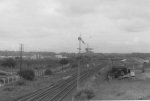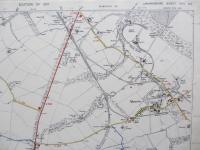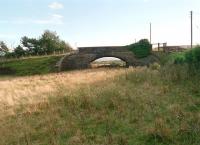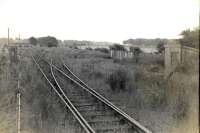Hamilton and Strathaven Railway
Introduction
This railway is closed. It ran from Strathaven Junction, Hamilton, initially west, then south, to Strathaven [1st] on the northern edge of the village serving a number of coal mines close to Hamilton and Quarter. Ground was taken to allow the line to be doubled. The summit of the line was at Quarter at 733 ft. The line rose quite steeply and banking could be required the whole way out from Strathaven Junction.
Why built
The original proposal was as a private coal line from the Coalburn line serving the Blantyre Colliery. However, this would be expensive to build and it was proposed as a branch of the Hamilton line. Following this, its extension south to Strathaven was supported by local interests. The Caledonian Railway was a subscriber to shares, worked the line and took it over in 1864.
The line was promoted by William Smith Dixon, the coal and iron master, owner of the Blantyre Colliery. Blantyre Colliery Pit No 2 to Blantyre Colliery Pit No 4 were served by the portion as far as High Blantyre.
Beyond High Blantyre further pits were served, Udston Colliery (of the 1887 disaster), Eddleswood Colliery, Neilsland Colliery, the Quarter Collieries and ultimately Strathaven [1st] was reached.
In 1862 the Chairman was James Dunlop of the Clyde Iron Works, Deputy Chairman William Smith Dixon of the Govan Iron Works, J P Alson of Muirburn, Matthew Dick of Meikle Earnock, Colin R Dunlop of Milton Lockhart, Thomas Tennent banker of Strathaven, Robert Graeme of Wellhall, Jno Meikleham of the Clyde Iron Works.
Dates
Portions of line and locations
This line is divided into a number of portions.
Hamilton to Strathaven
In 1860 the first part of the Hamilton and Strathaven Railway opened, climbing from the 1849 Hamilton Branch (Caledonian Railway) to the higher ground to the west at High Blantyre and then turn south, ultimately reaching Strathaven [Flemington]. In particular this line would, for its northern portion between Hamilton and Quarter, serve many collieries en route.
...
See also
Hamilton Branch (Caledonian Railway)
This was the western apex of a triangle of junctions north of Hamilton West and south of Blantyre. The northern apex was Blantyre Junction [CR] and southern Strathaven Junction.
...

John Robin /07/1963
This was the junction for Blantyre Colliery Pit No 4 which was north west of the junction, between Blantyre and High Blantyre on the former Hamilton and Strathaven Railway.
...
Hunthill Junction was immediately north of High Blantyre, which unfortunately was not served by it. Just west on the East Kilbride route was the Rotten Calder Viaduct.
...
See also
Blantyre to East Kilbride Line (Caledonian Railway)
This was a two platform station on a double track line. The station buildings were typical Caledonian Railway style with a footbridge at the north end. Hunthill Junction was not far to the north.
...
This was the signal box for Udston Colliery. The colliery was on the west side of the line and the signal box on the east side at the point of connection.
...
This signal box was located between Udston Box (to the north, a box south of High Blantyre) and Earnock Junction (to the south, a box north of Meikle Earnock). There was a loading bank served by sidings north and south off a short loop on the west side of the line. The box was on the south of Wellhall Road, on the east side of the line.
...
This was the junction for the mineral line to Earnock Quarry, Stewartfield Quarry and Hartfield Quarry. From the junction the siding ran north east, passed through a loop, swung over the main line and ran west to a reversing spur with a loop near Udston. From there it continued to the quarries.
...
This was a two platform station to the south west of Meikle Earnock village itself. A number of mines opened nearby. Both platforms had buildings, a waiting shelter on the northbound and small station building on the southbound.
...
This was the junction for the Eddlewood Colliery and Neilsland Colliery. Both were on the east side of the line and the branch ran north from the junction to serve the collieries.
...
This was the site of a short lived station around 1869. It was located at Quarter Iron Works Junction.
...
This was a single platform station west of the village of Quarter. The platform was on the east (village) side of the single track line. There was a small goods yard on the east side, approached from the north. The signal box was at the south end of the station, west side of the line, just north of a level crossing.
...

Gordon Steel 18/04/2021
This station was a mile west of the village of Glassford. The station had a platform on the east (village) side of a single line.
...

Ewan Crawford //1996
This junction was north of Strathaven. It was formed between the 1863 Hamilton and Strathaven Railway and the 1904 Mid Lanark Lines (Caledonian Railway), a set of lines and connection made to link together the Caledonian Railway's lines in the area. Part of this was an extension west from Stonehouse [Lanarkshire] to Darvel. The line from Whiteshawgate would connect to this ...
More detailsSee also
Mid Lanark Lines (Caledonian Railway)

G H Robin collection by courtesy of the Mitchell Library, Glasgow 07/07/1953
This was the terminus of the line from Hamilton. The station was at Flemington, just to the north east of Strathaven.
...
Blantyre Curve
This junction was directly south of Blantyre station. It was between the 1849 Hamilton Branch (Caledonian Railway) and a curve opened in 1882 to allow coal trains from the 1860 Hamilton and Strathaven Railway direct access to Glasgow without reversal at Strathaven Junction. The far end of the curve was at Auchinraith Junction (also spelled Auchenraith).
...
See also
Hamilton Branch (Caledonian Railway)
This was the western apex of a triangle of junctions north of Hamilton West and south of Blantyre. The northern apex was Blantyre Junction [CR] and southern Strathaven Junction.
...

John Robin /07/1963
Auchinraith Colliery Branch
This was the western apex of a triangle of junctions north of Hamilton West and south of Blantyre. The northern apex was Blantyre Junction [CR] and southern Strathaven Junction.
...

John Robin /07/1963
This junction on the North British Railway's Blantyre branch gave access to Auchinraith Colliery Pits Nos 1 and 2. To the east was Birdsfield Siding and the connection to the main NBR Hamilton branch at Blantyre Junction [NBR].
...
See also
Glasgow, Bothwell, Hamilton and Coatbridge Railway
Blantyre No 4 Branch
The Blantyre Colliery was owned by William Smith Dixon. ...
More detailsThis was the junction for Blantyre Colliery Pit No 4 which was north west of the junction, between Blantyre and High Blantyre on the former Hamilton and Strathaven Railway.
...
Blantyre Pits Branch
This was a two platform station on a double track line. The station buildings were typical Caledonian Railway style with a footbridge at the north end. Hunthill Junction was not far to the north.
...
The Blantyre Colliery was owned by William Smith Dixon. The 1877 mining disaster was an explosion at nos 2 and particularly 3 pits leaving an appalling 207 dead. ...
More detailsThe Blantyre Colliery was owned by William Smith Dixon. The 1877 mining disaster was an explosion at nos 2 and particularly 3 pits leaving an appalling 207 dead.
...
Udston Colliery Branch
This was the signal box for Udston Colliery. The colliery was on the west side of the line and the signal box on the east side at the point of connection.
...
Earnock Quarry Branch
This was the junction for the mineral line to Earnock Quarry, Stewartfield Quarry and Hartfield Quarry. From the junction the siding ran north east, passed through a loop, swung over the main line and ran west to a reversing spur with a loop near Udston. From there it continued to the quarries.
...
Eddlewood Colliery Branch
This was the junction for the Eddlewood Colliery and Neilsland Colliery. Both were on the east side of the line and the branch ran north from the junction to serve the collieries.
...
Quarter Iron Works Branch
This was the site of a short lived station around 1869. It was located at Quarter Iron Works Junction.
...
This junction was north of Quarter station and was the start of a branch to the Quarter Iron Works. The branch was approached from the north.
...
This iron works was located at the former mining village of Quarter, just to its north. The site of the furnaces has been built over in recent years. Portions of the partly landscaped remains of the mineral railways approaching the site remain.
...
Fairholm Colliery Branch




